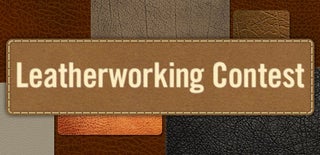Introduction: Tooled Leather Sheath
It's a lot of fun making knives. I read a bunch of instructables on knife making that were excellent and decided to make my own. The knife I made was from a super thick piece of steel that I had laying around. It has a mahogany handle and brass pins. Pretty simple. But this instructable is not about the knife. Here you'll see how I made a tooled sheath for it.
Step 1: Tools and Material
I used quite a few tools made for leather working, but you can get away with a lot less.
Tools
-knife
-stitching awl
-leather stamping or carving tools
-non-metal mallet (never use a steel hammer on your tools)
-leather edger or beveler
-sand paper
-wing divider
-saddlery needles
-hole punch
-straight edge
-cutting board
Materiales
-Vegetable tanned leather
-1 heavy duty snap
-2 rivets
-various leather dyes and/or paints
-Beeswax
Step 2: Make a Pattern
Make a simple paper pattern by tracing around the knife. Add about 1/8" as you scribe around it. That will give a little space to slide in and out. Then with a french curve add another 1/4".
Hold the knife at your side to see how high up you want it to sit and what direction you want it to face. Think about the snap and ease of releasing it. Once you know where you want it you can mark on your pattern where the belt loop will be. I wanted mine at a slight angle backwards so when you sit down it is a little out of your way. That is the fold line in the pic.
Step 3: Cut Pieces
This type of sheath is made of 4 pieces: Back, spacer,front and the snap strap. The spacer here is brown because it's a scrap from a previous project.
Mark out your pieces and cut them out with a sharp knife. Try to use enough pressure to cut through with one pass. Make sure knife is perpendicular to the cutting surface.
Step 4: Tool
With a wing divider or edge marker mark where your stitch will go on the front piece. You can also use a grooving tool that will make a small recess for the stitches to sit in (mines broken..argghh).
Soak your front piece in water for a few minutes. Make sure it's wet all the way through. Some let it sit wet in a sealed bag overnight. I don't. It's usually a good idea to draw your design on paper or vellum and then transfer it to your leather with a scratch awl.
Then use the swivel knife to cut the areas that you want to stamp the deepest. Only cut in about 1/3 of the thickness of the leather. You want to hold the swivel knife as shown in the 5th pic and make sure that the sides of the blade are perpendicular to the cutting surface. The blade edge gets tilted back as you cut. Try to cut in one smooth motion without stopping.
Then use the various stamping tools to emboss your image. Use the beveler to deeply impress the image around your cut lines.
Step 5: Color
Follow the manufacturers instructions on using the leather paints you have. Mine say to paint while leather is wet.
Step 6: Stitch Hidden Edges
Bevel and burnish any edges that will be difficult to do once assembled.
Bevel with edge beveler or sand paper then wet edge and rub with a piece of canvas really fast. This will fuse the fibers together and give a sheen. Dye the edge and let dry. Then repeat the burnishing but this time rub it with some beeswax also. This will seal it really well and give a nicer shine.
Here I glued the spacer in onto the back piece.
Step 7: Snap Strap
Figure out the length of your snap strap and where the snap should go. Don't make it to tight because the snap needs a bit of give to snap it together.
Step 8: Rivet Strap and Glue
Rivet the snap strap on and cement the front to the spacer
Step 9: Finish Edge and Stitch
Even up any irregularities between the three sandwiched layers with a piece of broken glass or a knife.
Bevel the edge and follow the whole edge finishing process detailed earlier.
Mark your stitches with an overstitch wheel or wing divider.
Using a stitching awl, 2 needles and a length of thread saddle stitch the sheath together. I like to use a stitching horse to hold the project for me.
Fold over the belt loop and stitch or rivet together.
Step 10: Finish
Rub with neat's foot oil or the recommended finish that your leather paints suggests. I oiled the whole sheath minus the painted front where it was sealed with a clear finish.
All done! Now your strapped.

First Prize in the
Leatherworking Contest

Participated in the
Great Outdoors Contest

Participated in the
Epilog Challenge VI

Participated in the
Outdoor Workshop Contest













